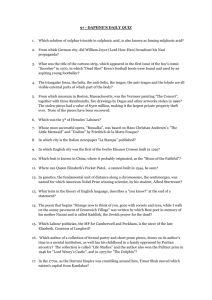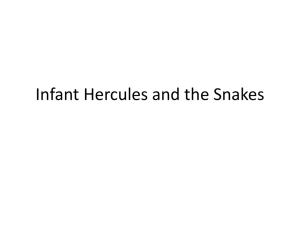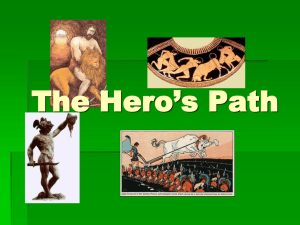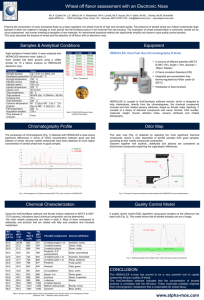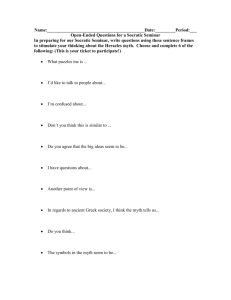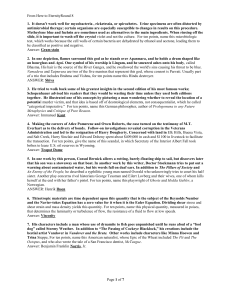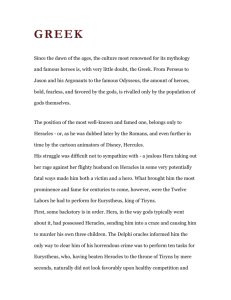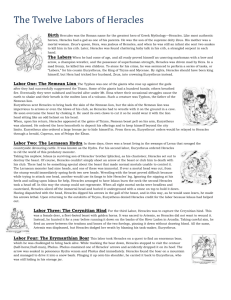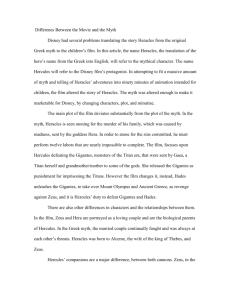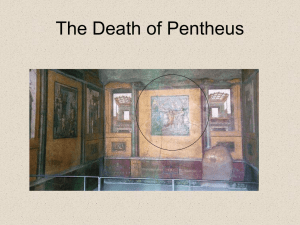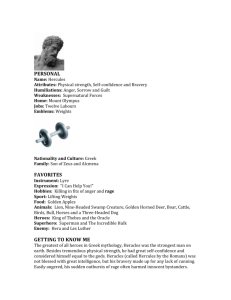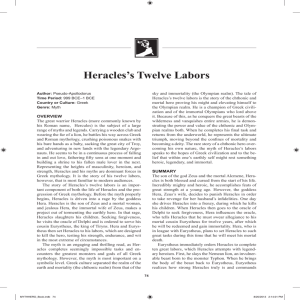Heracles (Hercules) – Great Greek Hero Hercules was the Roman
advertisement
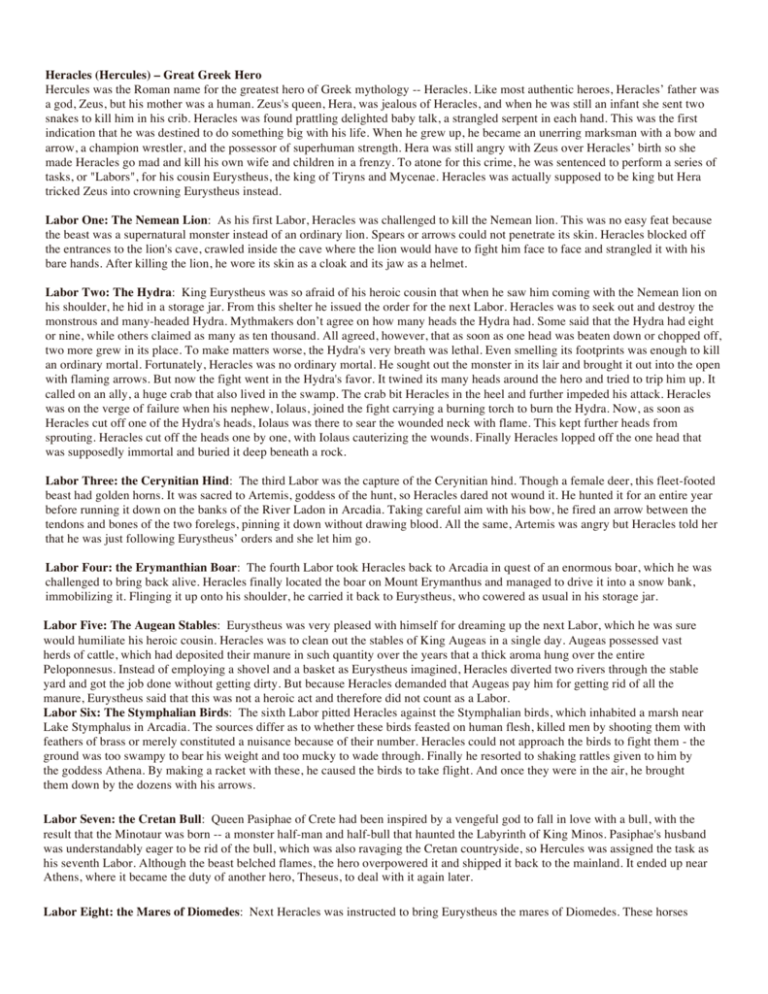
Heracles (Hercules) – Great Greek Hero Hercules was the Roman name for the greatest hero of Greek mythology -- Heracles. Like most authentic heroes, Heracles’ father was a god, Zeus, but his mother was a human. Zeus's queen, Hera, was jealous of Heracles, and when he was still an infant she sent two snakes to kill him in his crib. Heracles was found prattling delighted baby talk, a strangled serpent in each hand. This was the first indication that he was destined to do something big with his life. When he grew up, he became an unerring marksman with a bow and arrow, a champion wrestler, and the possessor of superhuman strength. Hera was still angry with Zeus over Heracles’ birth so she made Heracles go mad and kill his own wife and children in a frenzy. To atone for this crime, he was sentenced to perform a series of tasks, or "Labors", for his cousin Eurystheus, the king of Tiryns and Mycenae. Heracles was actually supposed to be king but Hera tricked Zeus into crowning Eurystheus instead. Labor One: The Nemean Lion: As his first Labor, Heracles was challenged to kill the Nemean lion. This was no easy feat because the beast was a supernatural monster instead of an ordinary lion. Spears or arrows could not penetrate its skin. Heracles blocked off the entrances to the lion's cave, crawled inside the cave where the lion would have to fight him face to face and strangled it with his bare hands. After killing the lion, he wore its skin as a cloak and its jaw as a helmet. Labor Two: The Hydra: King Eurystheus was so afraid of his heroic cousin that when he saw him coming with the Nemean lion on his shoulder, he hid in a storage jar. From this shelter he issued the order for the next Labor. Heracles was to seek out and destroy the monstrous and many-headed Hydra. Mythmakers don’t agree on how many heads the Hydra had. Some said that the Hydra had eight or nine, while others claimed as many as ten thousand. All agreed, however, that as soon as one head was beaten down or chopped off, two more grew in its place. To make matters worse, the Hydra's very breath was lethal. Even smelling its footprints was enough to kill an ordinary mortal. Fortunately, Heracles was no ordinary mortal. He sought out the monster in its lair and brought it out into the open with flaming arrows. But now the fight went in the Hydra's favor. It twined its many heads around the hero and tried to trip him up. It called on an ally, a huge crab that also lived in the swamp. The crab bit Heracles in the heel and further impeded his attack. Heracles was on the verge of failure when his nephew, Iolaus, joined the fight carrying a burning torch to burn the Hydra. Now, as soon as Heracles cut off one of the Hydra's heads, Iolaus was there to sear the wounded neck with flame. This kept further heads from sprouting. Heracles cut off the heads one by one, with Iolaus cauterizing the wounds. Finally Heracles lopped off the one head that was supposedly immortal and buried it deep beneath a rock. Labor Three: the Cerynitian Hind: The third Labor was the capture of the Cerynitian hind. Though a female deer, this fleet-footed beast had golden horns. It was sacred to Artemis, goddess of the hunt, so Heracles dared not wound it. He hunted it for an entire year before running it down on the banks of the River Ladon in Arcadia. Taking careful aim with his bow, he fired an arrow between the tendons and bones of the two forelegs, pinning it down without drawing blood. All the same, Artemis was angry but Heracles told her that he was just following Eurystheus’ orders and she let him go. Labor Four: the Erymanthian Boar: The fourth Labor took Heracles back to Arcadia in quest of an enormous boar, which he was challenged to bring back alive. Heracles finally located the boar on Mount Erymanthus and managed to drive it into a snow bank, immobilizing it. Flinging it up onto his shoulder, he carried it back to Eurystheus, who cowered as usual in his storage jar. Labor Five: The Augean Stables: Eurystheus was very pleased with himself for dreaming up the next Labor, which he was sure would humiliate his heroic cousin. Heracles was to clean out the stables of King Augeas in a single day. Augeas possessed vast herds of cattle, which had deposited their manure in such quantity over the years that a thick aroma hung over the entire Peloponnesus. Instead of employing a shovel and a basket as Eurystheus imagined, Heracles diverted two rivers through the stable yard and got the job done without getting dirty. But because Heracles demanded that Augeas pay him for getting rid of all the manure, Eurystheus said that this was not a heroic act and therefore did not count as a Labor. Labor Six: The Stymphalian Birds: The sixth Labor pitted Heracles against the Stymphalian birds, which inhabited a marsh near Lake Stymphalus in Arcadia. The sources differ as to whether these birds feasted on human flesh, killed men by shooting them with feathers of brass or merely constituted a nuisance because of their number. Heracles could not approach the birds to fight them - the ground was too swampy to bear his weight and too mucky to wade through. Finally he resorted to shaking rattles given to him by the goddess Athena. By making a racket with these, he caused the birds to take flight. And once they were in the air, he brought them down by the dozens with his arrows. Labor Seven: the Cretan Bull: Queen Pasiphae of Crete had been inspired by a vengeful god to fall in love with a bull, with the result that the Minotaur was born -- a monster half-man and half-bull that haunted the Labyrinth of King Minos. Pasiphae's husband was understandably eager to be rid of the bull, which was also ravaging the Cretan countryside, so Hercules was assigned the task as his seventh Labor. Although the beast belched flames, the hero overpowered it and shipped it back to the mainland. It ended up near Athens, where it became the duty of another hero, Theseus, to deal with it again later. Labor Eight: the Mares of Diomedes: Next Heracles was instructed to bring Eurystheus the mares of Diomedes. These horses dined on the flesh of travelers who made the mistake of accepting Diomedes' hospitality. In one version of the myth, Heracles pacified the beasts by feeding them their own master. In another, they satisfied their appetites on the hero's squire, a young man named Abderus. In any case, Heracles soon rounded them up and herded them down to sea, where he sent them to Eurystheus. Once Heracles had shown them to Eurystheus, he released them. Labor Nine: Hippolyte's Belt: The ninth Labor took Heracles to the land of the Amazons, to retrieve the belt of their queen for Eurystheus' daughter. The Amazons were a race of warrior women, great archers who had invented the art of fighting from horseback. Heracles recruited a number of heroes to accompany him on this expedition, among them Theseus. As it turned out, the Amazon queen, Hippolyte, willingly gave Hercules her belt, but Hera was not about to let the hero get off so easily. The goddess stirred up the Amazons with a rumor that the Greeks had captured their queen, and a great battle ensued. Heracles made off with the belt, and Theseus kidnapped an Amazon princess. Labor Ten: the Cattle of Geryon: In creating monsters and formidable foes, the Greek mythmakers used a simple technique of multiplication. Thus Geryon, the owner of some famous cattle that Heracles was now instructed to steal, had three heads and/or three separate bodies from the waist down. His watchdog, Orthrus, had only two heads. This Labor took place somewhere in the country we know as Spain. The hound Orthrus rushed at Heracles as he was making off with the cattle, and the hero killed him with a single blow from the wooden club, which he customarily carried. Geryon was dispatched as well, and Heracles drove the herd back to Greece, taking a wrong turn along the way and passing through Italy. Labor Eleven: the Apples of the Hesperides: The Hesperides were nymphs entrusted by the goddess Hera with certain apples, which she had received as a wedding present. These were kept in a grove surrounded by a high wall and guarded by Ladon, a manyheaded dragon. The grove was located in the far-western mountains named for Atlas, one of the Titans or first generation of gods. Atlas had sided with one of his brothers in a war against Zeus. In punishment, he was compelled to support the weight of the heavens by means of a pillar on his shoulders. Heracles, in quest of the apples, had been told that he would never get them without the aid of Atlas. The Titan was happy to help. Atlas told Heracles to hold the pillar while he went to get the fruit. When Atlas returned with the fruit, he realized that he was happy not to have to hold the pillar any more. Heracles wanted Atlas to take the pillar back so he told Atlas that he would be happy to hold up the pillow if Atlas would just give him a second to go get a pillow to put on his shoulder to make holding the pillar more comfortable. Atlas agreed and Heracles went off never to return. Labor Twelve: the Capture of Cerberus: As his final Labor, Heracles was instructed to bring the hound Cerberus up from Hades, the kingdom of the dead. The first barrier to the soul's journey beyond the grave was the famous river of the Underworld, the Styx. Here the newly dead congregated as insubstantial ghosts, mere wraiths of their former selves, awaiting passage in the ferryboat of Charon the Boatman. Charon wouldn't take anyone across unless they met two conditions. Firstly, they had to pay a bribe in the form of a coin under the corpse's tongue. And secondly, they had to be dead. Heracles was neither dead not did he have a coin which made Charon very grouchy. He didn’t want to take Heracles across the Styx but Heracles glowered so fiercely that Charon meekly conveyed him across the Styx. The greater challenge was Cerberus, who had razor teeth, three heads, a venomous snake for a tail, and another swarm of snakes growing out of his back. These lashed at Heracles while Cerberus lunged for a purchase on his throat. Fortunately, the hero was wearing his trusty lion's skin, which was impenetrable by anything short of a thunderbolt from Zeus. Heracles eventually choked Cerberus into submission and dragged him to Tiryns, where he received due credit for this final Labor. Death Heracles had a great many other adventures in later years, as well as in between his Labors. It was poisonous Hydra venom that eventually brought about his demise. He had allowed a centaur to ferry his wife Deianara across a river, and the centaur had attacked her on the other side. Heracles killed him with an arrow, but before the centaur died, he told Deinara to keep some of his blood for a love potion. Deinara used some of this potion on Heracles' tunic to keep him faithful not realizing that it had been poisoned with Hydra venom from the arrow. Heracles donned the tunic and died in agony. Afterlife Heracles was the only hero to become a full-fledged god upon his death, but even in his case there was his mortal aspect to be dealt with. By virtue of his spectacular achievements, even by heroic standards, he was given a home on Mount Olympus and a goddess for a wife. But part of him had come not from his father Zeus but from his mortal mother Alcmene, and that part was sent to the Underworld. As a ghost, it eternally roams the Elysian Fields in the company of other heroes.
